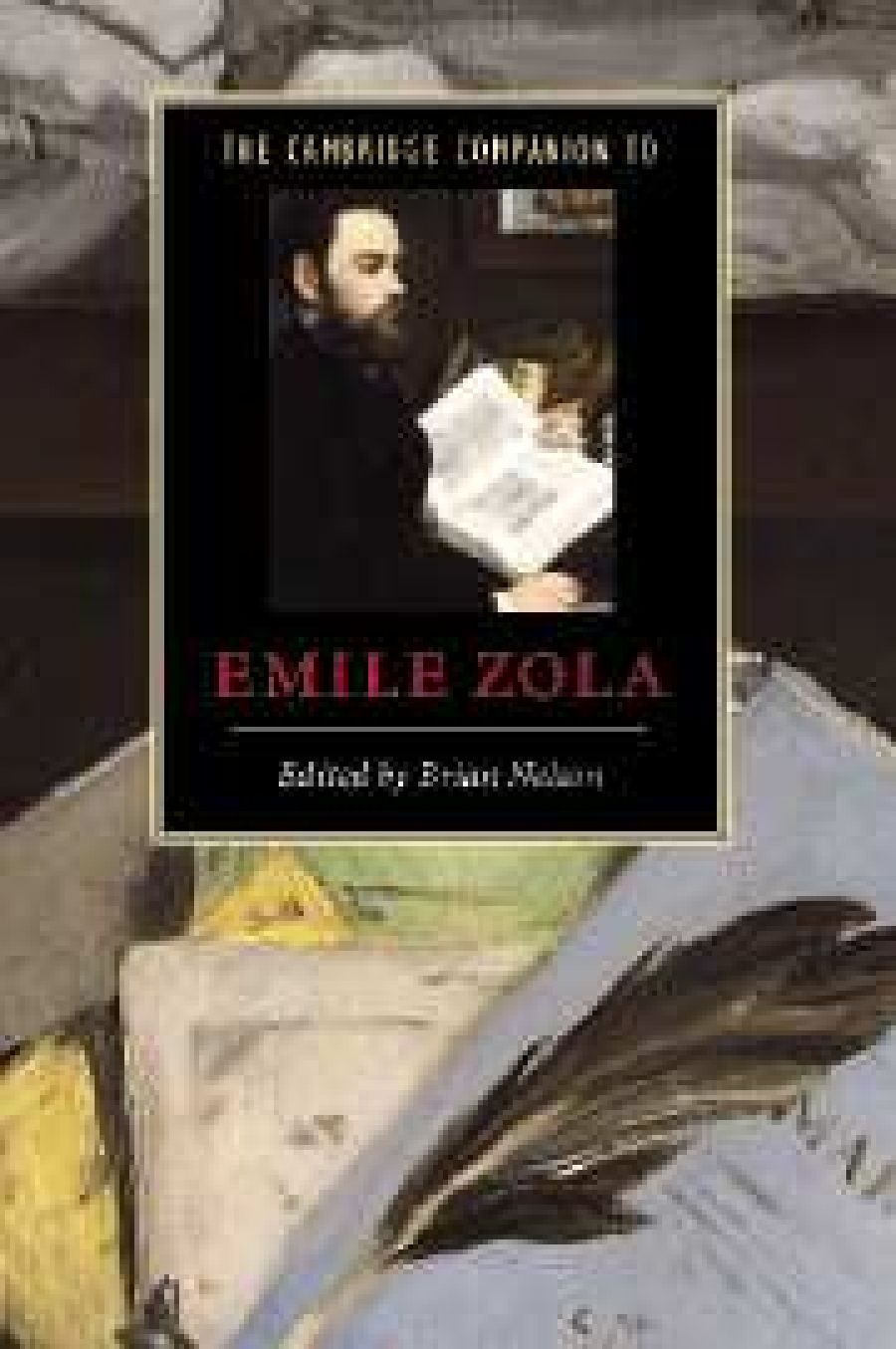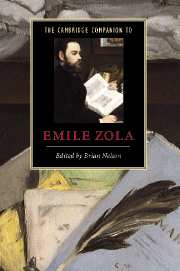
- Free Article: No
- Contents Category: Literary Studies
- Custom Article Title: The Zola Affair
- Review Article: Yes
- Article Title: The Zola Affair
- Online Only: No
- Custom Highlight Text:
'Why read Emile Zola?’ asks one of the contributors to this volume. ‘Because his representation of society’s impact on individuals within it memorably depicts what it means to be a human being in the modern world.’ The publication of The Cambridge Companion to Emile Zola, edited by Brian Nelson, Professor of French Studies at Monash University, will be of great assistance in reading and rereading this realist writer, and will doubtless become an indispensable tool for researchers and students.
What do these essays reveal? The fascination which the naturalist novelist Zola (1840–1902) still exercises on his readers because of the profoundly organic nature of his writing. Despite the meticulous planning and the scientific method and framework underlying his enterprise to describe the social and familial milieux (the subtitle of the twenty novels [1871–93] comprising Les Rougon-Macquart is The Natural and Social History of a Family under the Second Empire), Zola’s art stems from its evocative power, its descriptive force, in a word, its ‘excitement’.
- Book 1 Title: The Cambridge Companion to Emile Zola
- Book 1 Biblio: CUP, $49.95 pb, 218 pp
- Book 1 Cover Small (400 x 600):

- Book 1 Cover (800 x 1200):

This beautiful collection of essays brings together eminent French and Anglo-Saxon academics, who are all specialists in one or two aspects of Zola, and who, through a series of analyses focusing on the major novels, evoke the grand themes of Zola’s work: the importance of the family unit and its social environment, always oppressive, often to the point of repugnance; sexual aberrations resulting in flaws being passed from one generation to the next; but also reflections on art and science, as well as political commitment in what was the first great cause of the committed intellectual, the Dreyfus Affair (1894–1906).
The approach of this remarkably coherent volume – which includes a chronology, a summary of the novels and an extensive bibliography of Zola scholarship, including cutting-edge research – is to provide studies of the grand themes of Zola’s work, which is often compared to a magnificent edifice or an enormous tree, with a complex system of branches spreading in multiple directions (each novel in the Rougon-Macquart series follows the fortunes of one descendant) and with roots deep in the nineteenth-century psyche.
Brian Nelson’s opening essay provides an overview of Zola’s work. Inspired by the illustrious Balzac’s Comédie humaine, Zola’s novels are set during the galloping, speculative industrialisation of France under the Second Empire of Napoleon III. Following the descendants of Adélaïde Fouque, her husband Rougon and lover Macquart, each novel explores a social milieu, from the peasantry frozen in quasi-pre-revolutionary values, through the proletariat experiencing the beginnings of socialist protest, to the Parisian lower and upper middle class, totally shaken by the economic and artistic upheavals of the capital. This historical sectioning is coupled with a ‘scientific’ investigation: Zola, a positivist, identifies as a follower of Claude Bernard and experimental medicine. What he hunts down like a sleuth is the original flaw, the madness transmitted from generation to generation by an hysterical grandmother, a madness which haunts each character, one of whom sinks into debauchery, another into alcoholism and crime, yet another into the madness of money and power. Destroying the healthy stock, contaminating everything in its way, the hereditary flaw will, however, be suspended in the last novel, Le Docteur Pascal (1893), whose doctor hero, double of Zola, studying the case of this accursed family, will, as a novelist, stand back enough to decide to put an end to the family’s ongoing turpitude.
But scientific proof, and Zola’s intention to become the physiologist and dissector of this little world, give way to the writing project. Happily for the reader, the world as Zola would like to capture it, in its human and social reality, is entirely subordi-nated to the pleasure of vision and fiction, whose magic starts with the titles: La Bête Humaine (1890), Germinal (1885), Nana (1880). The sparkling, intricate plots captivate the reader. A new way of writing, nurtured by the influence of the painters of his time, as Robert Lethbridge’s essay points out, appears through the plans and the notes. For the first time, a writer goes down a mine (for Germinal), copies the speech of peasants (La Terre [1887]), observes the frenzy of department stores (Au Bonheur des Dames [1883]). The naturalist writer is born. His creative processes are particularly well demonstrated in Chantal Pierre-Gnassounou’s contribution. Far from slavishly observing reality, as the myth which was carefully cultivated by Zola himself would have it, he lets himself be led by his imagination, his fantasies and his passion for melodrama, even if ‘the ‘superego’ of the naturalist generally intervenes in the end to repress the melodramatic drives of the author ...’
It is impossible for a reader of Zola to forget the pyramids of victuals in Le Ventre de Paris (1873), Gervaise’s descent into the hell of alcoholism in L’Assommoir (1877), or the garden where the guilty love of the young priest Serge Mouret and the young Albine is consummated in La Faute de l’Abbé Mouret (1875). These memorable scenes are im-printed in the reader’s imagination and emblematise an entire epoch, from the workers’ revolt, which is severely repressed by a reactionary régime to the galloping urbanism of Haussman’s Paris, from which emerge modern icons: the theatre, the brothel, the boudoir, the artist’s studio (Zola was also a recognised art critic who was fond of Manet but not of Cézanne, who was too indecisive for his liking).
Beyond the plots (stories of families, of money, of inheritance) Zola’s style is a dazzling repertoire of forces which invade, crush, consume human flesh, like the terrible Voreux, or the mine shaft in Germinal, which, like Moloch, devours workers. External forces (machines, mines, society) and internal ones (alcoholism, disease, insanity and also a concept which Zola, a reader of the psychiatrist Pierre Janet, starts to explore, the unconscious) join together to deform bodies and minds: each novel presents the mythological combat of the individual against the deadly forces of time, passion and, above all, madness. Social pressures, on the one hand, carnal instincts and criminal impulses on the other, drive the narrative: men are greedy, pleasure-seeking, sometimes brutal; and women (Nana, Thérèse Raquin) are splendid, dangerous animals.
Zola is the first example of what one could call a writer with a social conscience, since a good number of his novels deal with the aspirations and the vicissitudes of ordinary people and society’s rejects. Served by robust and physical language (Zola was accused of obscenity), they herald what will be Zola’s ultimate commitment in the battle to free Captain Dreyfus, unjustly accused of high treason. Zola’s letter (‘J’accuse ...’), addressed to the president of the Republic, Félix Faure, remains a model of eloquent and impassioned argumentation, for which, one often forgets, he was persecuted and punished with a prison sentence (which he avoided by fleeing to England).
What emerges from this collection of essays for everyone – non-specialists and specialists alike – is the passion which is always unleashed when reading Zola, and which shows no sign of diminishing a century on. By guiding us behind the scenes of his work with the aid of a range of critical approaches (genetic criticism, sociological criticism, feminist studies, amongst others) and of elegant but sound analysis, this book invites readers to immerse or re-immerse themselves in a prose which has lost nothing of its energy or vitality.


Comments powered by CComment